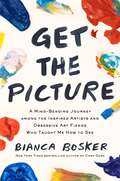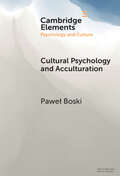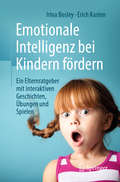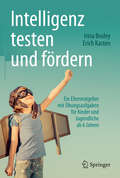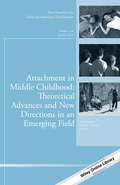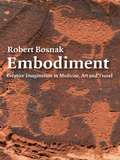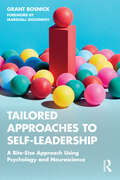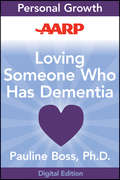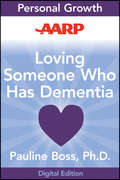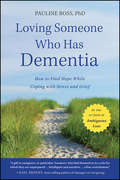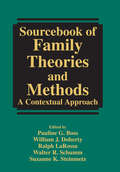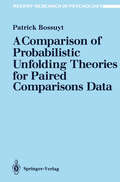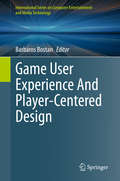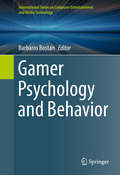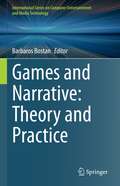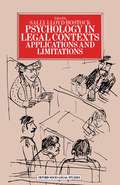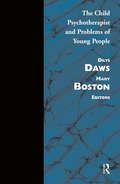- Table View
- List View
Get The Picture: A Mind-bending Journey Among The Inspired Artists And Obsessive Art Fiends Who Taught Me How To See
by Bianca BoskerCultural Psychology and Acculturation (Elements in Psychology and Culture)
by null Pawel BoskiThis Element offers a new theoretical model of acculturation within the general framework of cultural psychology. It is divided into four sections. First, cross-cultural and cultural orientations are contrasted. The psychology of economic migration (EARN), separate from the psychology of acculturation (LEARN), is the theme of the next section. Berry's model of acculturation preferences is discussed in section three. It serves as a contrasting reference point for the tripartite model of bicultural competencies, developed in the final section. The three interconnected components are symbols, language, and values/practices characterize both enculturation and acculturation. As a second culture learning process, acculturation is not restricted to immigration. It may take a vicarious (remote) shape in the home country. Reaching bicultural competencies and identities, in the long run, is the proposed outcome of acculturation.
Transgender Health Issues (Health and Medical Issues Today)
by Sarah BoslaughTransgender individuals face unique challenges when it comes to their physical, psychological, and social health and well-being. This accessible reference investigates these concerns in depth, offering readers insights into topics such as discrimination and access to health care.Although transgender individuals have always existed, their fight for acceptance and equal rights is just beginning. Within this larger context, one area of emerging concern is their health—physical, psychological, and social. From legislation determining public restroom access to insurance coverage of hormone therapy for transitioning individuals to harassment and discrimination, transgender people face a number of challenges that can negatively affect their well-being.A part of Greenwood's Health and Medical Issues Today series, Part I of this book explores definitions of sex and gender, the history of transgender awareness and activism, physical and psychological health concerns specific to transgender individuals, and how identifying as transgender can have different effects on individuals' health at different stages in their life. Part II examines issues and controversies related to the health and well-being of transgender individuals. Part III provides a variety of useful materials, including case studies, a timeline of critical events, a glossary, and a directory of resources.
Transgender Health Issues (Health and Medical Issues Today)
by Sarah BoslaughTransgender individuals face unique challenges when it comes to their physical, psychological, and social health and well-being. This accessible reference investigates these concerns in depth, offering readers insights into topics such as discrimination and access to health care.Although transgender individuals have always existed, their fight for acceptance and equal rights is just beginning. Within this larger context, one area of emerging concern is their health—physical, psychological, and social. From legislation determining public restroom access to insurance coverage of hormone therapy for transitioning individuals to harassment and discrimination, transgender people face a number of challenges that can negatively affect their well-being.A part of Greenwood's Health and Medical Issues Today series, Part I of this book explores definitions of sex and gender, the history of transgender awareness and activism, physical and psychological health concerns specific to transgender individuals, and how identifying as transgender can have different effects on individuals' health at different stages in their life. Part II examines issues and controversies related to the health and well-being of transgender individuals. Part III provides a variety of useful materials, including case studies, a timeline of critical events, a glossary, and a directory of resources.
Emotionale Intelligenz: Ein Ratgeber mit Übungsaufgaben für Kinder, Jugendliche und Erwachsene
by Irina Bosley Erich KastenWelches sind die Erfolgsfaktoren für ein gelingendes Leben in Beruf und Alltag? Dieser Ratgeber illustriert anschaulich und basierend auf psychologischen Theorien und Erkenntnissen, dass neben kognitiv-rationaler Intelligenz (gemeinhin als „IQ“ bezeichnet) vor allem emotionale und soziale Kompetenzen dazugehören, die essentiell für das Zusammenleben und -arbeiten mit anderen Menschen sind. Ausgehend von psychologischen Grundlagen, die dem Verständnis von emotionaler Intelligenz (auch als „EQ“ bezeichnet) dienen, werden IQ und EQ gegenübergestellt und deren jeweilige Bedeutung und Zusammenwirken als Erfolgsfaktor im Leben beschrieben. Die Autoren zeigen, dass sich emotionale Intelligenz durch einzelne emotionale und soziale Kompetenzen (wie z.B. Emotionserkennung, Selbstregulation und Empathie) beschreiben und mit bestimmten Verfahren sogar messen lässt.Abgerundet wird das Buch durch zahlreiche Übungsaufgaben für alle Altersklassen, mit denen sich der EQ trainieren lässt und damit einen direkten positiven Einfluss auf das eigene Leben hat.
Emotionale Intelligenz bei Kindern fördern: Ein Elternratgeber mit interaktiven Geschichten, Übungen und Spielen
by Irina Bosley Erich KastenSoziale und emotionale Kompetenzen beeinflussen unsere Fähigkeiten, Emotionen bei sich und anderen richtig einzuschätzen und regulieren zu können, positive Ziele zu setzen und zu erreichen, Empathie für andere zu zeigen, Beziehungen aufzubauen und aufrechtzuerhalten sowie verantwortungsvolle Entscheidungen zu treffen. Neben den kognitiven Fähigkeiten verhelfen sie nicht nur in der Schule, sondern in allen Lebensbereichen zum Erfolg. Aus diesem Grund ist es gerade bei Kindern wichtig, eine gesunde Entwicklung im Umgang mit ihren Gefühlen sowie ihren zwischenmenschlichen Beziehungen zu fördern.In diesem Elternratgeber werden die psychologischen Grundlagen sowie die Bedeutung der emotionalen Intelligenz kompakt und anschaulich anhand von Beispielen erklärt. Im Fokus stehen fünf Kompetenzgruppen des Sozial-Emotionalen Lernens (SEL) bei Kindern: Selbstwahrnehmung, soziales Bewusstsein, Selbstmanagement, verantwortungsvolle Entscheidungen und Beziehungsmanagement. In einem zweiten, ausführlichen Übungsteil mit zahlreichen kindgerechten Illustrationen zeigen die Autoren, wie Sie als Eltern die emotionalen Kompetenzen Ihrer Kinder mit interaktiven Geschichten, vielfältigen Übungsaufgaben und Spielen im Alltag fördern können.
Intelligenz testen und fördern: Ein Elternratgeber mit Übungsaufgaben für Kinder und Jugendliche ab 6 Jahren
by Irina Bosley Erich KastenWas ist Intelligenz? Wie kann diese bei Kindern gemessen und gefördert werden? Und was geschieht eigentlich bei einem IQ-Test? Dieser Ratgeber erklärt Eltern gut verständlich und wissenschaftlich fundiert, wie man die geistigen Potenziale des Nachwuchses entdecken und fördern kann.Nach einer Einleitung und Erklärung, welche Intelligenztheorien und -modelle es gibt, werden ausführlich sieben Intelligenzbereiche erläutert: sprachgebundenes Denken, anschauungsgebundenes Denken, zahlengebundenes Denken, Verarbeitungskapazität, Einfallsreichtum, Merkfähigkeit und Bearbeitungsgeschwindigkeit. Um aufzuzeigen, wie das geistige Potenzial in diesen Bereichen bestimmt werden kann, werden einige der bekanntesten Intelligenztests mit Beispielaufgaben vorgestellt. Ergänzend erhalten Eltern Anregungen, wie sie die einzelnen Intelligenzbereiche durch einfache spielerische Übungen im Alltag fördern können. Die Autoren verdeutlichen, welche Komponenten die schulische Hochleistung eines Kindes beeinflussen, an welchen Merkmalen Minder- und Hochbegabung beim Kind entdeckt werden können und was Eltern tun können, damit ihre Kinder glücklich und schlau aufwachsen.
Attachment in Middle Childhood: New Directions for Child and Adolescent Development, Number 148 (J-B CAD Single Issue Child & Adolescent Development)
by Guy Bosmans Kathryn A. KernsOne of the critical factors in early development is the formation of a secure attachment, and it continues to be important for older children's responses to psychological stressors like hurt pride, fear, and sadness. This volume provides a timely review of research to date, describing important insights that have both theoretical and clinical importance as well as identifying remaining gaps in our understanding.Summarizing the most relevant findings, this volume is important for theory on child (attachment) development, and also for clinicians to broaden their understanding of the importance of middle childhood attachment processes for understanding the development of children’s behavior problems and for designing effective treatment strategies.This is the 148th volume in this Jossey-Bass series New Directions for Child and Adolescent Development. Its mission is to provide scientific and scholarly presentations on cutting edge issues and concepts in this subject area. Each volume focuses on a specific new direction or research topic and is edited by experts from that field.
Attachment in Middle Childhood: New Directions for Child and Adolescent Development, Number 148 (J-B CAD Single Issue Child & Adolescent Development)
by Guy Bosmans Kathryn A. KernsOne of the critical factors in early development is the formation of a secure attachment, and it continues to be important for older children's responses to psychological stressors like hurt pride, fear, and sadness. This volume provides a timely review of research to date, describing important insights that have both theoretical and clinical importance as well as identifying remaining gaps in our understanding.Summarizing the most relevant findings, this volume is important for theory on child (attachment) development, and also for clinicians to broaden their understanding of the importance of middle childhood attachment processes for understanding the development of children’s behavior problems and for designing effective treatment strategies.This is the 148th volume in this Jossey-Bass series New Directions for Child and Adolescent Development. Its mission is to provide scientific and scholarly presentations on cutting edge issues and concepts in this subject area. Each volume focuses on a specific new direction or research topic and is edited by experts from that field.
Embodiment: Creative Imagination in Medicine, Art and Travel
by Robert BosnakDid you know that intentional dreaming has been used to solve life's problems? Embodiment: Creative Imagination in Medicine, Art and Travel sets out Robert Bosnak's practice of embodied imagination and demonstrates how he actually works with dreams and memories in groups. The book discusses various approaches to dreams, body and imagination, and combines this with a Jungian, neurobiological, relational and cultural analysis. The author's fascination with dreams, the most absolute form of embodied imagination, has caused him to travel all over the world. From his research he concludes that while dreaming everyone everywhere experiences dreams as embodied events in time and space while the dreamer is convinced of being awake; it is after waking into our specific cultural stories about dreaming that the widely differing attitudes towards dreams arise. By taking dreaming reality, not our waking interpretation of it, as the model for imagination, this book creates a paradigm shock and produces methods which can be applied in a wide variety of cultural settings. Through detailed case studies, professionals and students will find thorough discussions of: ways to flashback into dreams and memories while in a hypnagogic state of consciousness the practice of embodied imagination and its profound physical effects psyche as a self-organizing multiplicity of selves the nature of subjectivity the body as a theatre of sense memories the limitation of reason the process of dissociation the treatment of trauma This book discusses a variety of techniques which may be applied by health professionals to their patients and clients. It will also be of particular interest to Jungian and relational psychoanalysts, psychotherapists and clinical psychologists, as well as to artists, actors, directors, writers and other individuals who wish to explore the creative imagination.
Embodiment: Creative Imagination in Medicine, Art and Travel
by Robert BosnakDid you know that intentional dreaming has been used to solve life's problems? Embodiment: Creative Imagination in Medicine, Art and Travel sets out Robert Bosnak's practice of embodied imagination and demonstrates how he actually works with dreams and memories in groups. The book discusses various approaches to dreams, body and imagination, and combines this with a Jungian, neurobiological, relational and cultural analysis. The author's fascination with dreams, the most absolute form of embodied imagination, has caused him to travel all over the world. From his research he concludes that while dreaming everyone everywhere experiences dreams as embodied events in time and space while the dreamer is convinced of being awake; it is after waking into our specific cultural stories about dreaming that the widely differing attitudes towards dreams arise. By taking dreaming reality, not our waking interpretation of it, as the model for imagination, this book creates a paradigm shock and produces methods which can be applied in a wide variety of cultural settings. Through detailed case studies, professionals and students will find thorough discussions of: ways to flashback into dreams and memories while in a hypnagogic state of consciousness the practice of embodied imagination and its profound physical effects psyche as a self-organizing multiplicity of selves the nature of subjectivity the body as a theatre of sense memories the limitation of reason the process of dissociation the treatment of trauma This book discusses a variety of techniques which may be applied by health professionals to their patients and clients. It will also be of particular interest to Jungian and relational psychoanalysts, psychotherapists and clinical psychologists, as well as to artists, actors, directors, writers and other individuals who wish to explore the creative imagination.
Tailored Approaches to Self-Leadership: A Bite-Size Approach Using Psychology and Neuroscience
by Grant BosnickThis book provides a uniquely adaptable approach to develop awareness (of self, others and one’s environment) of self-leadership through real behavioral change. Through neuroscience, psychology and behavioral science approaches, each chapter will help readers make their learning and development personal and take it to a deeper level. With a tip of the hat to the gamebook format where you choose your adventure, readers are encouraged to take an original online self-assessment quiz to determine the challenges and priorities they are presently facing. The quiz then provides a suggested reading order of chapters to address these growth areas. Each of the 18 chapters explores a different theme related to self-leadership and are written in such a way that one can read them in any order. Filled with practical activities, reflective questions and personal anecdotes, Bosnick encourages readers to understand behavior from the "inside-out" of neuroscience and how the brain works, while also keeping an eye on the "outside-in:" how we understand others and how others see us. Combining research-backed principles with tried-and-tested exercises, this is a book tailored for leaders of all levels, professionals in a transitory phase of their career, as well as those just starting out in the working world.
Tailored Approaches to Self-Leadership: A Bite-Size Approach Using Psychology and Neuroscience
by Grant BosnickThis book provides a uniquely adaptable approach to develop awareness (of self, others and one’s environment) of self-leadership through real behavioral change. Through neuroscience, psychology and behavioral science approaches, each chapter will help readers make their learning and development personal and take it to a deeper level. With a tip of the hat to the gamebook format where you choose your adventure, readers are encouraged to take an original online self-assessment quiz to determine the challenges and priorities they are presently facing. The quiz then provides a suggested reading order of chapters to address these growth areas. Each of the 18 chapters explores a different theme related to self-leadership and are written in such a way that one can read them in any order. Filled with practical activities, reflective questions and personal anecdotes, Bosnick encourages readers to understand behavior from the "inside-out" of neuroscience and how the brain works, while also keeping an eye on the "outside-in:" how we understand others and how others see us. Combining research-backed principles with tried-and-tested exercises, this is a book tailored for leaders of all levels, professionals in a transitory phase of their career, as well as those just starting out in the working world.
AARP Loving Someone Who Has Dementia: How to Find Hope while Coping with Stress and Grief
by Pauline BossAARP Digital Editions offer you practical tips, proven solutions, and expert guidance. In Loving Someone Who Has Dementia, Pauline Boss provides research-based advice for people who care for someone with dementia. Nearly half of U.S. citizens over the age of 85 are suffering from some kind of dementia and require care. Loving Someone Who Has Dementia is a new kind of caregiving book. It's not about the usual techniques, but about how to manage on-going stress and grief. The book is for caregivers, family members, friends, neighbors as well as educators and professionals—anyone touched by the epidemic of dementia. Dr. Boss helps caregivers find hope in "ambiguous loss"—having a loved one both here and not here, physically present but psychologically absent. Outlines seven guidelines to stay resilient while caring for someone who has dementia Discusses the meaning of relationships with individuals who are cognitively impaired and no longer as they used to be Offers approaches to understand and cope with the emotional strain of care-giving Boss's book builds on research and clinical experience, yet the material is presented as a conversation. She shows you a way to embrace rather than resist the ambiguity in your relationship with someone who has dementia.
AARP Loving Someone Who Has Dementia: How to Find Hope while Coping with Stress and Grief
by Pauline BossAARP Digital Editions offer you practical tips, proven solutions, and expert guidance. In Loving Someone Who Has Dementia, Pauline Boss provides research-based advice for people who care for someone with dementia. Nearly half of U.S. citizens over the age of 85 are suffering from some kind of dementia and require care. Loving Someone Who Has Dementia is a new kind of caregiving book. It's not about the usual techniques, but about how to manage on-going stress and grief. The book is for caregivers, family members, friends, neighbors as well as educators and professionals—anyone touched by the epidemic of dementia. Dr. Boss helps caregivers find hope in "ambiguous loss"—having a loved one both here and not here, physically present but psychologically absent. Outlines seven guidelines to stay resilient while caring for someone who has dementia Discusses the meaning of relationships with individuals who are cognitively impaired and no longer as they used to be Offers approaches to understand and cope with the emotional strain of care-giving Boss's book builds on research and clinical experience, yet the material is presented as a conversation. She shows you a way to embrace rather than resist the ambiguity in your relationship with someone who has dementia.
Loving Someone Who Has Dementia: How to Find Hope while Coping with Stress and Grief
by Pauline BossResearch-based advice for people who care for someone with dementia Nearly half of U.S. citizens over the age of 85 are suffering from some kind of dementia and require care. Loving Someone Who Has Dementia is a new kind of caregiving book. It's not about the usual techniques, but about how to manage on-going stress and grief. The book is for caregivers, family members, friends, neighbors as well as educators and professionals—anyone touched by the epidemic of dementia. Dr. Boss helps caregivers find hope in "ambiguous loss"—having a loved one both here and not here, physically present but psychologically absent. Outlines seven guidelines to stay resilient while caring for someone who has dementia Discusses the meaning of relationships with individuals who are cognitively impaired and no longer as they used to be Offers approaches to understand and cope with the emotional strain of care-giving Boss's book builds on research and clinical experience, yet the material is presented as a conversation. She shows you a way to embrace rather than resist the ambiguity in your relationship with someone who has dementia.
Loving Someone Who Has Dementia: How to Find Hope while Coping with Stress and Grief
by Pauline BossResearch-based advice for people who care for someone with dementia Nearly half of U.S. citizens over the age of 85 are suffering from some kind of dementia and require care. Loving Someone Who Has Dementia is a new kind of caregiving book. It's not about the usual techniques, but about how to manage on-going stress and grief. The book is for caregivers, family members, friends, neighbors as well as educators and professionals—anyone touched by the epidemic of dementia. Dr. Boss helps caregivers find hope in "ambiguous loss"—having a loved one both here and not here, physically present but psychologically absent. Outlines seven guidelines to stay resilient while caring for someone who has dementia Discusses the meaning of relationships with individuals who are cognitively impaired and no longer as they used to be Offers approaches to understand and cope with the emotional strain of care-giving Boss's book builds on research and clinical experience, yet the material is presented as a conversation. She shows you a way to embrace rather than resist the ambiguity in your relationship with someone who has dementia.
Sourcebook of Family Theories and Methods: A Contextual Approach
by Pauline Boss William J. Doherty Ralph LaRossa Walter R. Schumm Suzanne K. SteinmetzOrigins We call this book on theoretical orientations and methodological strategies in family studies a sourcebook because it details the social and personal roots (i.e., sources) from which these orientations and strategies flow. Thus, an appropriate way to preface this book is to talk first of its roots, its beginnings. In the mid 1980s there emerged in some quarters the sense that it was time for family studies to take stock of itself. A goal was thus set to write a book that, like Janus, would face both backward and forward a book that would give readers both a perspec tive on the past and a map for the future. There were precedents for such a project: The Handbook of Marriage and the Family edited by Harold Christensen and published in 1964; the two Contemporary Theories about theFamily volumes edited by Wesley Burr, Reuben Hill, F. Ivan Nye, and Ira Reiss, published in 1979; and the Handbook of Marriage and the Family edited by Marvin Sussman and Suzanne Steinmetz, then in production.
Mathematik fachfremd unterrichten: Zur Professionalität fachbezogener Lehrer-Identität (Essener Beiträge zur Mathematikdidaktik)
by Marc BosseMithilfe eines neutral-phänomenologischen Forschungsansatzes und eines von Wissensdefiziten losgelösten Professionalitätsbegriffs untersucht Marc Bosse fachfremd unterrichtende Mathematiklehrpersonen hinsichtlich ihrer mathematikbezogenen Erfahrungen und in Bezug auf ihr Verhältnis zum Fach. Die zentrale Erkenntnis der ersten deutschen Studie zu diesem Thema ist, dass eine fehlende formale Lehrbefähigung für Mathematik nicht festlegt, wie sich die betreffenden Lehrpersonen als Mathematiklehrerinnen und -lehrer sehen und welcher identitätstheoretische Grad an Professionalität ihnen attestiert werden kann. Als empirische Grundlage dienen die Befragung von Lehrerinnen und Lehrern sowie die Beobachtung von Mathematikunterricht. Die Arbeit liefert ein Modell von sechs Identitätstypen, mit dem sich die Heterogenität hinsichtlich der Erfahrungs- und Verhältnisfrage beschreiben lässt.
A Comparison of Probabilistic Unfolding Theories for Paired Comparisons Data (Recent Research in Psychology)
by Patrick BossuytSome data-analytic methods excel by their sheer elegance. Their basic principles seem to have a particular attraction, based on a intricate combination of simplicity, deliberation, and power. They usually balance on the verge of two disciplines, data-analysis and foundational measurement, or statistics and psychology. To me, unfolding has always been one of them. The theory and the original methodology were created by Clyde Coombs (1912-1988) to describe and analyze preferential choice data. The fundamental assumptions are truly psy chological; Unfolding is based on the notion of a single peaked preference function over a psychological similarity space, or, in an alternative but equivalent expression, on the assumption of implicit comparisons with an ideal alternative. Unfolding has proved to be a very constructive data-analytic principle, and a source of inspiration for many theories on choice behavior. Yet the number of applications has not lived up to the acclaim the theory has received among mathematical psychologists. One of the reasons is that it requires far more consistency in human choice behavior than can be expected. Several authors have tried to attenuate these requirements by turning the deterministic unfolding theory into a probabilistic one. Since Coombs first put forth a probabilistic version of his theory, a number of competing proposals have been presented in the literature over the past thirty years. This monograph contains a summary and a comparison of unfolding theories for paired comparisons data, and an evaluation strategy designed to assess the validity of these theories in empirical choice tasks.
Game User Experience And Player-Centered Design (International Series on Computer Entertainment and Media Technology)
by Barbaros BostanThis book provides an introduction and overview of the rapidly evolving topic of game user experience, presenting the new perspectives employed by researchers and the industry, and highlighting the recent empirical findings that illustrate the nature of it. The first section deals with cognition and player psychology, the second section includes new research on modeling and measuring player experience, the third section focuses on the impact of game user experience on game design processes and game development cycles, the fourth section presents player experience case studies on contemporary computer games, and the final section demonstrates the evolution of game user experience in the new era of VR and AR.The book is suitable for students and professionals with different disciplinary backgrounds such as computer science, game design, software engineering, psychology, interactive media, and many others.
Gamer Psychology and Behavior (International Series on Computer Entertainment and Media Technology)
by Barbaros BostanThis book provides an introduction and overview of the increasingly important topic of gamer psychology and behavior by presenting a range of theoretic perspectives and empirical evidence casting new light on understanding gamer behavior and designing interactive gaming experiences that maximize fun. This book aims to provide a snapshot on research approaches/advances in player psychology and behavior, discuss issues, solutions, challenges, and needs for player behavior research, and report gameplay experience and lessons as well as industry case studies from both social sciences and engineering perspectives. The nine chapters in this book, which are divided into three sections: Neuro-Psychology and Gaming; Player Behavior and Gameplay; Player Psychology and Motivations, do not represent all the topics in the psychology of gaming, however, they include a variety of topics in this field: the effects of violent video games on cognitive processes, the reward systems in the human brain and the concept of 'fun', goal-directed player behavior and game choices, psychological player profiling techniques, game design requirements and player psychology, motivational gamer profiles, and many more.This book is suitable for students and professionals with different disciplinary backgrounds such as computer science, design, software engineering, psychology, interactive media, and information systems. Students will be interested in the theory of gamer psychology and its impact on game design. Professionals will be interested in the fundamentals of gamer behavior and how interactive virtual environments can improve user experience.
Games and Narrative: Theory and Practice (International Series on Computer Entertainment and Media Technology)
by Barbaros BostanThis book provides an introduction and overview of the rapidly evolving topic of game narratives, presenting the new perspectives employed by researchers and the industry, highlighting the recent empirical findings that illustrate the nature of it. The first section deals with narrative design and theory, the second section includes social and cultural studies on game narrative, the third section focuses on new technologies and approaches for the topic, the fourth section presents practices and case studies, and the final section provides industry cases from professionals.
Psychology in Legal Contexts: Applications and Limitations (Oxford Socio-Legal Studies)
by Sally M.Lloyd- BostockChild Psychotherapist and Problems of Young People
by Mary Boston Dilys DawsMany parents at some time dread that a child of theirs may be mentally ill or disturbed. But even after a generation of child psychology, psychiatry and psychotherapy, they still frequently fear to admit their fears, and fear the mystery of the remedy as much as the mystery of the problem. It is therefore important that parents should come to easy terms with the work of the psychotherapist, and be reassured that it is based on sympathetic understanding, not mysteries. It was to explain themselves to parents and others who work with other young people that sixteen psychotherapists and analysts (mostly following the principles of Anna Freud or Melanie Klein and largely drawn from the Hampstead Child Therapy and the Tavistock clinics in London) decided to collaborate in the preparation of this book. In it they set out to describe their work in schools, hospitals, clinics, day centres, etc and to discuss their fundamental approach to the treatment of the disturbed child.
